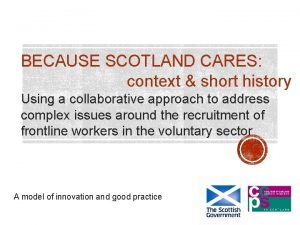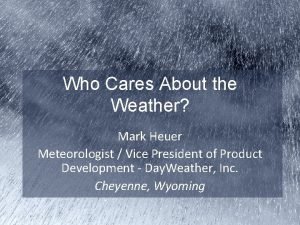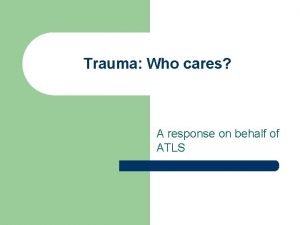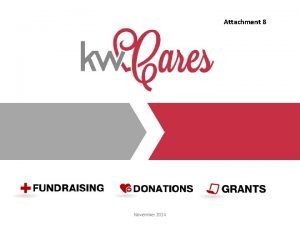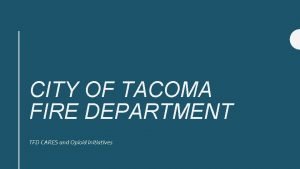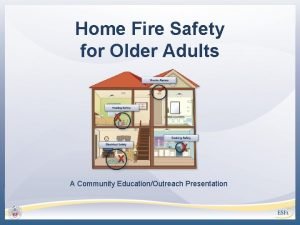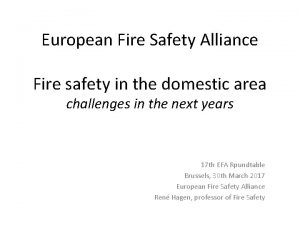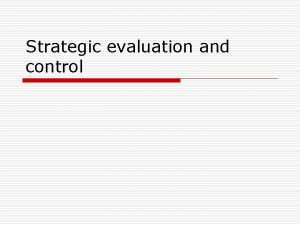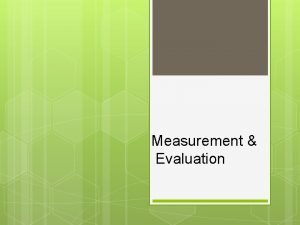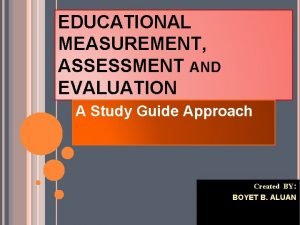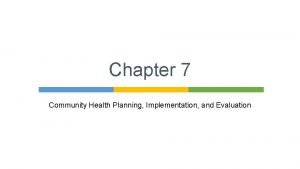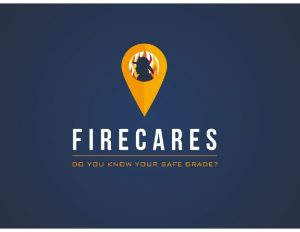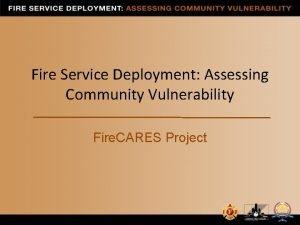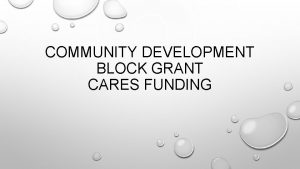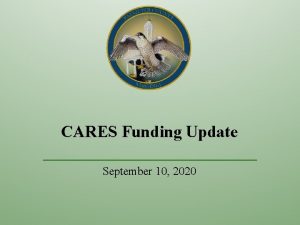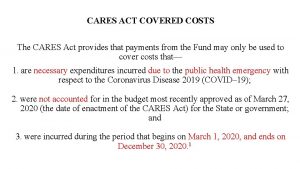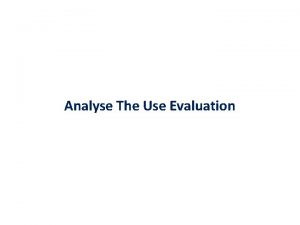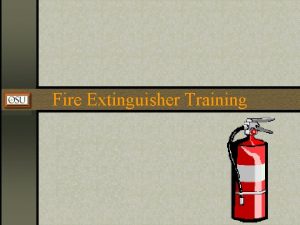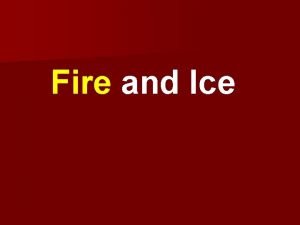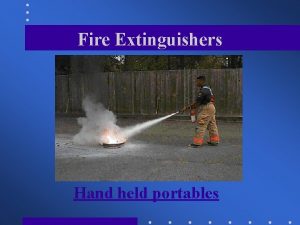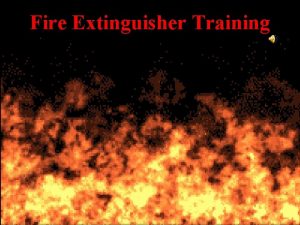1 Community Assessment RiskResponse Evaluation System Fire CARES































- Slides: 31

1

Community Assessment Risk/Response Evaluation System: Fire. CARES May 2016 2

Fire Department Core Values Protect lives, property, and the environment through preparedness, prevention, public education, and emergency response with an emphasis on quality services, efficiency, effectiveness, and safety. 3

Challenges Are Driving Dangerous Decisions • Forcing decisions to cut fire department resources faster than we can evaluate their impact • Cuts can leave a community without sufficient resources to respond safely and effectively 4

Matching Resources to Risk If fire department resources (both mobile and personnel) are deployed to match the risk levels inherent to hazards in the community, it has been scientifically demonstrated that the community will be far less vulnerable to negative outcomes in… • firefighter injury and death • civilian injury and death • property loss 5

Matching Resources to Risk • Following a community hazard/risk assessment, Leaders must prepare a plan for timely and sufficient coverage of all hazards and the adverse risk events that occur…. Standard of Response Coverage. (Standards of Cover) 6

Fire Department Performance • Resource Availability/Reliability is the degree to which the resources are ready and available to respond. • Department Capability is the ability of the resources deployed to manage an incident. • Operational Effectiveness is the product of availability and capability. It is the outcome achieved by the deployed resources or a measure of the ability to match resources deployed to the risk level to which they are responding. 7

Fire Service Leaders Faced with Decisions • When evaluating current capability or measuring impact of a change in the level of resources deployed, department leaders (and community officials) must decide: 1. What resources to commit to risk management (prevention/preplanning/preparation); 2. What resources to commit to response/mitigation 3. The acceptable level of risk. 8

Fire Service Leaders Faced with Decisions • Decisions must be based on understanding of – relationship between community hazards and associated risk, – basic emergency response infrastructure, including fire department response capability – outcomes of emergency incidents 9

Matching Resources to Risk If fire department resources (both mobile and personnel) are deployed to match the risk levels inherent to hazards in the community, it has been scientifically demonstrated that the community will be far less vulnerable to negative outcomes in… • firefighter injury and death • civilian injury and death • property loss 10

Fire. CARES = • Community Assessment/ Response Evaluation System • Same Study Team as NIST Studies • DHS/AFG Grant • DOD – ROGUE project 11

Fire. CARES • GIS-based tool is being constructed of multiple layers of “Big Data” § Real estate data § Public health data § Census data § Building foot prints § HAZUS data – And multiple other GIS layers including 11+ years of structure fire data 12

Fire. CARES • High-Hazard Occupancies – High-rise buildings, hospitals, schools, nursing homes, explosive plants, refineries, public assembly structures, and other high life hazard or large fire potential occupancies. • Medium-Hazard Occupancies – Apartments, offices, mercantile and industrial occupancies that may require extensive use of fire fighting forces. • Low-Hazard Occupancies – One-, two- or threefamily dwellings and scattered small business and industrial occupancies. 13

Fire. CARES • Data layers are compiled to build the ‘risk profile’ or the community risk assessment for Fire departments • Includes national fire station layer • Other local response related data can be added to the system § hydrant locations § inspection reports 14

Connections: Bringing It All Together National Fire Operations Reporting System 15

www. firecares. org 16


Introducing the Intelligent Fire Data Reducing Injury, Death, and Damage National Fire Operations Reporting System

N-FORS Funding 2013 - 2015

VISION TO REALITY Intelligent Fire Data Reducing Injury, Death, and Damage

Project Goals Assure Adequate Fire Resources Optimize Fire Operations Minimize Civilian Injury and Death Reduce Firefighter Injury and Death Minimize Property Loss

N-FORS Stakeholder Group • • • • • • • Assistance to Firefighters Grant Program California Fire Chiefs Association Commission on Fire Accreditation International Emergency Performance Inc. United States Fire Administration Fire Cancer Support Network Fire Application Industry International Academy of Emergency Dispatch International Association of Arson Investigators International Association of Fire Chiefs International Association of Fire Fighters International City/County Management Association International Fire Service Training Association ISO Local Fire Application Users National Association of State Fire Marshals National Fallen Firefighters Foundation National Fire Data Center (NFIRS) National Fire Protection Association National Institute of Standards and Technology National League of Cities NEMSIS Technical Assistance Center National Volunteer Fire Councill Pro Board The Urban Institute Worchester Polytechnic Institute

N-FORS Approach What How • NFIRS Documents the Incident of Fire • N-FORS Documents the same PLUS the Operations Required to Manage It

N-FORS Application Modules (Data Segments) • Configuration • Event Operations • Fire, Rescue, Investigations, Haz. Mat, EMS, etc… • Health, Wellness, & Outcome Ø FF Exposure tracking- Career Diary • Reports Available Immediately

Second Nature Usability • Event Operations Centric • Intuitive • Minimal Clicks • Auto-Save • Normal Work Flow • (Decision Trees) • Business Logic

More Than What You See Modern IT and Data Systems • Works on Multiple Devices • CAD data capture/ extraction • Reduce the burden of data entry • Connectivity • The Cloud • Leverages Existing Data

N-FORS Specifications Web-Based (Hosted NFPA) • Minimal Data Entry from Field • CAD Data Uploads • CAD Policy for data capture = Operations Tasks • Data Entry Feedback • Real-Time Analysis = Resource Status

Health and Wellness Report Civilian • Injury, Exposure, Death • Associated with Incident Firefighter • Near Miss • Injury, Exposure, Death • Any On the Job Event

Federal Statutes • • The reporting of fire data is voluntary and not mandated. Local Fire Department participation is based on one of the two following requirements: Ø An individual state’s requirement to collect and submit NFIRS data Ø Receipt of funds from the FEMA Assistance to Firefighter Grant Program

State Statutes/Regulations States • State participation in NFIRS is voluntary. • 17 – NFIRS required • 4 – questionable whether NFORS could be implemented • 29 – Relatively clear path for NFORS implementation Ø Political advocacy underway to assure pathway for NFORS use.

What’s Next? Next Steps • Transition project to new home at NFPA • Complete programming and module testing for implementation • Assure data exchange capability with other data systems • Fire. CARES • Cancer Registry • YFIRES (Juvenile Fire Setters) • Live Data Feeds (Utility, taxes, parcels)
 Gm socrates
Gm socrates No one cared for my soul
No one cared for my soul Is imana cares fake
Is imana cares fake Urbanization in the lorax
Urbanization in the lorax Cares rebar
Cares rebar Cares engagement network
Cares engagement network Lord cares
Lord cares Norfolk cares hotline
Norfolk cares hotline No one cares for my soul
No one cares for my soul Famu cares act
Famu cares act Because scotland cares
Because scotland cares Back up care advantage
Back up care advantage O yes he cares
O yes he cares Mark heuer
Mark heuer Trauma who cares
Trauma who cares Uwecares
Uwecares Kw cares application
Kw cares application Don't get entangled in civilian affairs
Don't get entangled in civilian affairs Sarasota county cares grant
Sarasota county cares grant Utep cares
Utep cares Fire extinguisher service tacoma
Fire extinguisher service tacoma Reichstag fire who was the fire starter
Reichstag fire who was the fire starter Fire damper access
Fire damper access Uttar pradesh fire prevention & fire safety rules, 2005
Uttar pradesh fire prevention & fire safety rules, 2005 Ire fire fire rwi
Ire fire fire rwi Fire extinguisher parts
Fire extinguisher parts European fire safety community
European fire safety community European fire safety community
European fire safety community Richard rumelt criteria for strategy audit
Richard rumelt criteria for strategy audit Concept map of measurement assessment and evaluation
Concept map of measurement assessment and evaluation Prognostic test
Prognostic test Community health planning and implementation certificate
Community health planning and implementation certificate










